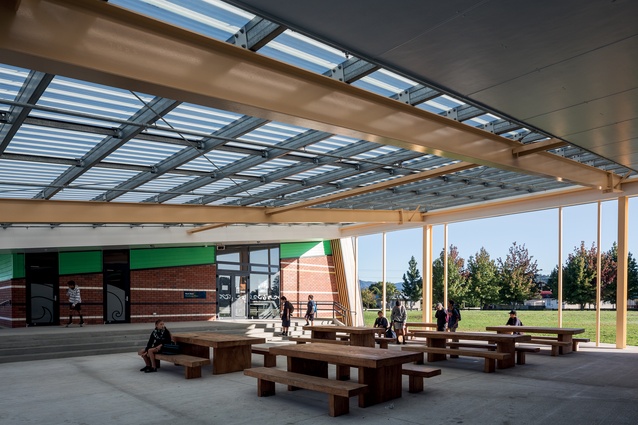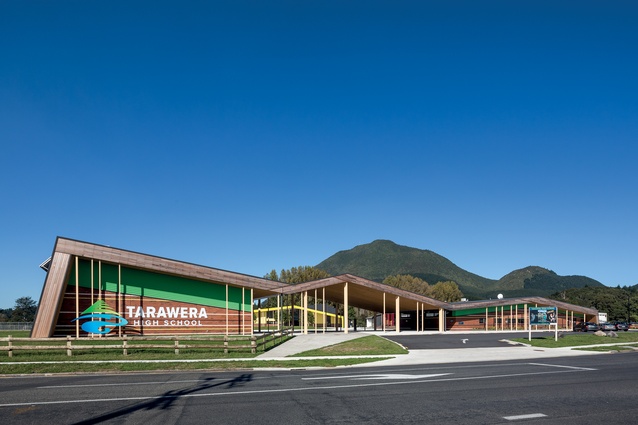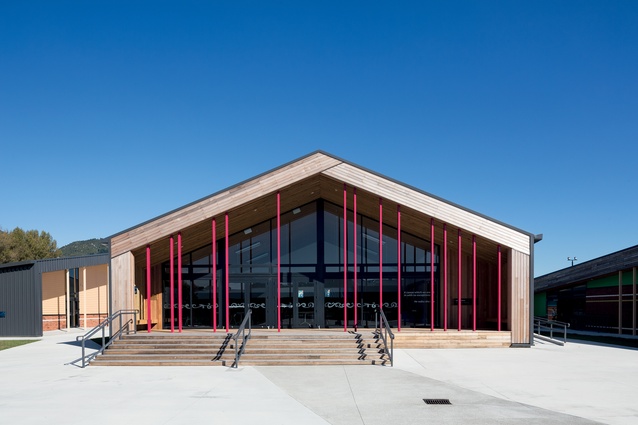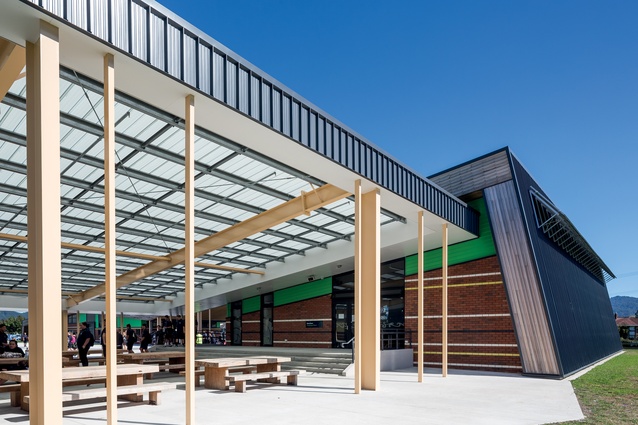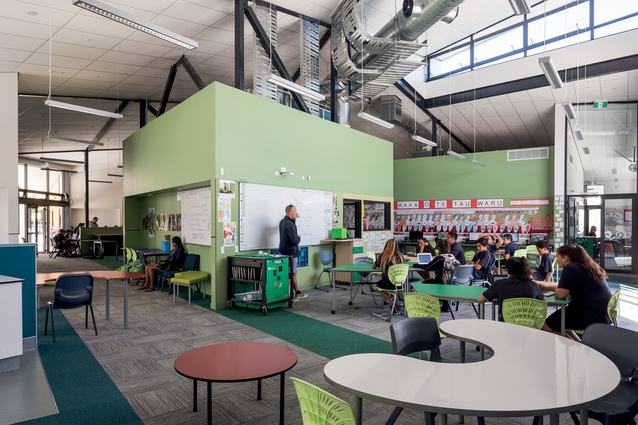Turning a new page: Tarawera High School
RTA Studio Architects’ bold and innovative design has supported the transformation of a previously troubled school in Kawerau, in the Bay of Plenty. Justine Harvey interviewed Rich Naish about RTA Studio’s design for Tarawera High School.
Justine Harvey: What was your vision for the design?
Rich Naish: The background was that Kawerau is a very poor community and Tarawera High School is a decile 1 school. The original school [Kawerau College] was in decline and the truancy rate was around 50 per cent and the staff had lost interest. When we first walked around the original buildings, there were only about three or four students in some classes. The actual demographic of the school is about 90 per cent Maori, even though the town is about 50 per cent, so that’s a story in itself.
JH: Where I grew up in Waverley in South Taranaki, many of the Pākeha children went away to boarding school and the local high school was eventually closed because of a dwindling roll.
RN: The previous high school [Kawerau College] was closed because of population decline in the town. The Ministry closed one primary school and the intermediate, as well as the college, in order to establish a new school on the site that would cater for Years 7 to 13 – combining the two campuses basically. An Establishment Board of Trustees (EBOT) was created and they had to advertise all the staff positions, to which existing staff could reapply. When Tarawera High School opened, they were short on staff but, this year, they have teachers applying to work there when they aren’t even advertising for staff.
When we first were assigned the job and became involved, there was a lot of controversy in the community – a lot of disappointment that the intermediate had shut down and because teachers and principals had lost their jobs – so we pretty much arrived during a very difficult time.
We first met with the EBOT to discuss their vision for the school. Kaumatua advisor Sonny Rua talked about ‘turning a new page’ – a new beginning; starting afresh but acknowledging the past. That really stuck with me as a genesis statement. Other things that stuck were the Tarawera River nearby and the local mountain, Putauaki. To cut a long story short, we liked the idea of incorporating leylines.
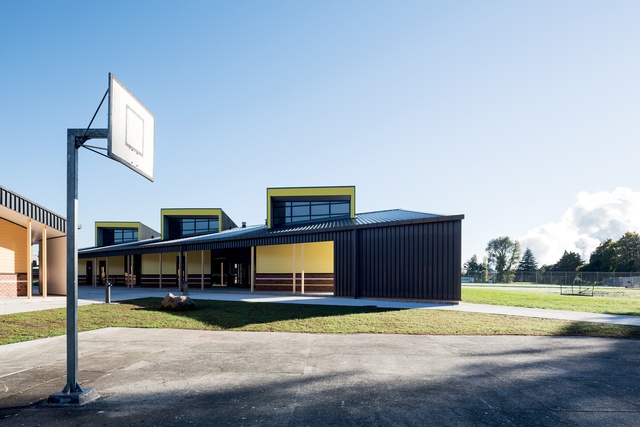
JH: So this project connects to your design for Te Kura Kaupapa in Wairoa, which was also designed around leylines?
RN: Yes, this was the first of the two projects we designed, really, but they are both connected to Professor Paul Tapsell, who we are designing a house for in Rotorua, because this leyline development happened through his house. So, I credit him as a collaborator on some of these ideas we’ve been using on a number of schools but, it’s personal with every group really.
With this group, the obvious questions are: what is your mountain, what is your river, what is your ocean? Of course, Putauaki is the mountain, Tarawera is the river and Maketu is a spot on the coast where the first canoes arrived, and the school just happened to be on a straight line between Putauaki and Maketu. Also, where the Tarawera River meets the coast is where some ancestors arrived in their wakas.
Those three landscape leylines are the major points that defined the planning of the school and relate to the past – locking the design into the whakapapa of the iwi, while the future includes the new buildings. We also added a line which links to the town centre – a community connection, to add to the three landscape connections. We established a street on the axis to the mountain and faced the wharenui to the axis pointing to where the Tarawera River meets the coast.
Our masterplan proposed potential locations for expanded learning houses and a new sports hall, which would be linked back into the community. If you look at a diagram or plan of the old school, you can see that it held no relationship to these new lines because it was built on the classic 1950s’ Ministry of Works’ idea that you plonk a school down with no relationship to nearby natural features.

JH: How are the buildings organised around the leylines?
RN: When you arrive, you are immediately focused on the mountain, which makes sense. Under the canopy entrance, administration is sited on one side and performing arts is on the other. Then, as you walk through, you have the wharekai or food technology house and a canopy over an outdoor eating space. The wharenui fronts the technology block behind; it’s like an arts and culture centre. And then there are two learning houses, which are these two big open-plan classrooms on either side of the street.
JH: The canopies are great spaces for the students to hang out if it’s wet outside.
RN: Yes. We had to fight quite hard for funding from the Ministry to have these areas built for those, as it has restrictive budgets. But we could do it on the basis that there are quite extreme climates in Kawerau – it’s hot in the summer and cool in the winter.
JH: Outdoor areas are fairly fundamental to a New Zealand school, I would have thought.
RN: Yes, and we have covered outdoor teaching spaces all the way around these classrooms as well; we were therefore very lucky to have been able to include so many outdoor covered spaces.
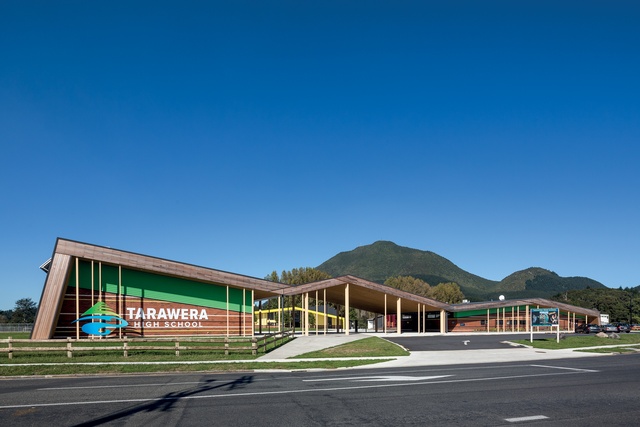
JH: I like the way the decorative timber bargeboards fold over the top of one another, along the folding roofline – it’s an interesting feature.
RN: Yes. We wanted to link up with the timber of this timber-mill town, as well as the folding of the landscape and with weaving as a craft. We just try to screw every last millimetre of building that we make, to layer it with context and meaning so that, no matter what walk of life you come from, hopefully you’re going to bang your head on one of the meanings on one of the days of the week!
JH: How do the open-plan learning houses work?
RN: There are three learning spaces within each of the two houses. I guess each one of the pop-ups in the roof represents a classroom and each classroom caters for 90 students; so you have 270 kids in one classroom essentially, and there is a mirror image of that on the other side of the street. You also have all these pockets of space and outdoor teaching areas under the roof overhangs and then there are verandahs too.
JH: So, presumably the teachers are not teaching 270 students all at once?
RN: The houses can be broken up to cater for different groups: a break-out space might cater for six to twelve students, a specialised space can operate as a science lab or an arts space and cater for about 25 students, then there are focused-learning spaces that will take a group of four to six. There is tiered seating in which to host a film. The spaces are interchangeable and flexible, and there are teaching stations for 10 to 12 teachers in each block.
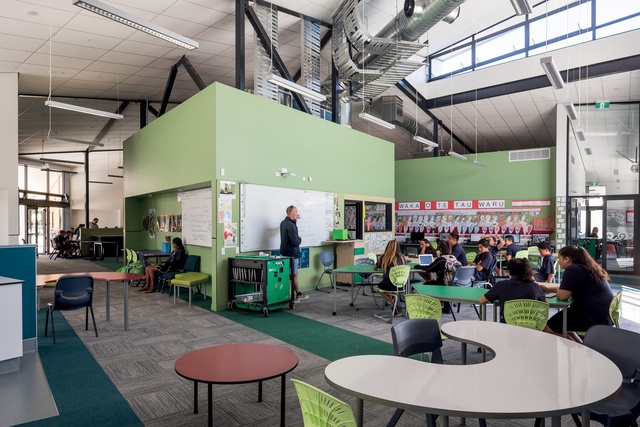
JH: Was the school familiar with Modern Learning Environments [MLE]?
RN: A few of the senior teachers had MLE experience – Innovative Learning Environments or ILE experience is what they call it now – and the principal, Helen Tuhoro, is a really passionate, wonderful woman, who was keen to upskill and learn about the ILE process; in fact, she became a real advocate for it. We had to work really hard with the school and the board to challenge them and push them towards a whole new way of teaching.

This is a difficult thing for an architect to do, but we were supported by the Ministry, which introduced a consultant to help the school and the community to understand what this new learning and teaching environment would look like. We all toured other ILE schools [in New Zealand], although we found there were community-specific idiosyncrasies, which meant we had to change the way we did some things.
But the success story in all of this is that the school has increased its NCEA Level 1 pass results from around 35 per cent over three years ago to 85 per cent in 2015. Now it’s one of the highest-performing decile 1 schools in the country. Attendance is also now up around 80 per cent. Some of that began to occur before the buildings were finished – we’re not taking all of the credit, of course, as the result is obviously led by a really passionate teaching programme headed by Helen but, also, the positivity of the building project about to happen, happening and now finished has contributed to that success. It was great to hear the Minister Hekia Parata quoting those statistics at the opening of the school recently.
While it has certainly been a challenging project the whole way through, we are happy that it’s been so successful and we’re very pleased to say that it was built for the same cost as many of the other schools being built up and down the country.




